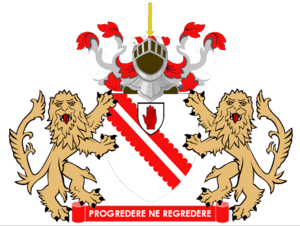William Honyman, Lord Armadale facts for kids
Sir William Honyman, 1st Baronet (born December 1756 – died 5 June 1835), also known as Lord Armadale, was an important Scottish landowner and judge from Orkney. He was one of the first landowners in Sutherland to move people off their land to create large sheep farms. This process later became known as the Highland Clearances.
Lord Armadale used his political influence in Orkney to help his family members become Members of Parliament (MPs). First, his brother Robert became an MP, then his son Robert, and finally his younger son Richard.
Contents
Who Was William Honyman?
William Honyman came from a well-known family. His father, Patrick Honyman, was from Graemsay in Orkney. The family was connected to Andrew Honyman, a Bishop of Orkney in the 1600s. They also believed they were related to Sir Robert Stewart, who was a son of King James V of Scotland.
His mother, Margaret MacKay, was the daughter of Captain John MacKay. Her family was connected to the Clan MacKay, a powerful Scottish clan.
His Career as a Judge
Honyman became a lawyer in 1777. In 1786, he became the Sheriff-Depute of Lanarkshire. A sheriff-depute was like a chief judge for a region.
As Sheriff, he was involved in looking into the activities of Thomas Muir of Huntershill, a political reformer. Honyman questioned people for Muir's trial, where Muir was accused of trying to stir up trouble against the government. The main judge in this case was Lord Braxfield, who was also Honyman's father-in-law.
Honyman's early career was helped by Sir Lawrence Dundas, 1st Baronet. Sir Lawrence had bought important lands in Orkney and Zetland. In the 1770s, the Honyman family supported Sir Lawrence and his son, Colonel Thomas Dundas, who was the MP for Orkney and Shetland.
In 1797, Honyman became a judge. In 1799, he joined the Lords of Justiciary, which was Scotland's highest criminal court. In 1804, he was given the special title of baronet. He chose the name Armadale for his title, after lands he owned in Sutherland. He left his judge jobs in 1811 and moved to his estate called Smyllum Park in Lanarkshire.
Political Influence in Orkney
Even though he was a judge, Honyman was very active in politics in Orkney. The Dundas family, who had a lot of political control, were being challenged by Henry Dundas. In the 1780s, the Honymans decided to support Henry Dundas instead.
In the 1790 election, William Honyman helped John Balfour win the election in Orkney. Balfour defeated Sir Lawrence Dundas's son, Thomas.
By the 1796 election, Honyman hoped his own son, Robert, who was only 15, could become an MP when he was old enough. After talking with Balfour, Honyman arranged for his half-brother, Commander Robert, to hold the seat until young Robert was old enough.
Despite some challenges, young Robert (who was now 25 and a Major in the 93rd Foot army regiment) was elected for Orkney in 1806. However, soon after being elected, he was promoted in the army and never actually voted or spoke in the House of Commons.
By the 1807 election, Honyman supported another candidate, Malcolm Laing. Laing's health got worse, and in the 1812 election, Honyman's opponents were divided. This allowed Honyman's younger son, Richard, to be elected. (His older son Robert had died in Jamaica in 1808). However, Honyman's rivals later joined forces against his family. After that, the Orkney MP seat was shared between the Balfour, Dundas, and Laing families.
Changes in Sutherland
In 1790, Honyman bought land at Strathy on the north coast of Sutherland from his grandfather, Captain John Mackay. This land included Armadale, which Honyman later used for his judge title.
Honyman was one of the first landowners in northern Scotland to realize that raising sheep could make more money than traditional farming. He became one of the leaders of the Highland Clearances. This was a time when many people were moved off their land to make way for large sheep farms.
Honyman divided his estate into three parts. By 1800, he had moved the people from the Armadale valley to a new village near the coast. He then created a large Armadale Sheep Farm. In 1813, he sold the estate to the Marquess of Stafford (who later became the 1st Duke of Sutherland). The Duke continued the process of moving people off the land.
Armadale in West Lothian
Also in 1790, Honyman bought land in West Lothian called Barbauchlaw. He renamed this area Armadale.
His Family Life
In 1777, Honyman married Mary McQueen, who was the daughter of Lord Braxfield. They had at least five sons and four daughters. Two of their oldest sons joined the British Army. Patrick served in the 28th Light Dragoons, and Robert became a Lieutenant colonel in the 18th Regiment of Foot.
In 1820, a book called The Black Book: Or, Corruption Unmasked by John Wade listed pensions paid by the government. It showed that Sir William received £1,800 a year as a retired judge. This was a lot of money back then. The book was updated in 1831, and it noted that Lady Mary Honyman, his wife, was given a pension of £137 per year in 1814. Their four daughters, Mary, Catherine, Margaret, and Jemima, each received an additional £37 per year in 1815.
The book criticized the Honyman family, saying it was "most extraordinary" that they received these pensions since they already owned a lot of land. The Scottish Reformers Gazette suggested that these payments might have been connected to Sir William Honyman's actions as Sheriff in 1793, when he was very active in gathering information against Thomas Muir of Huntershill.
Arms


